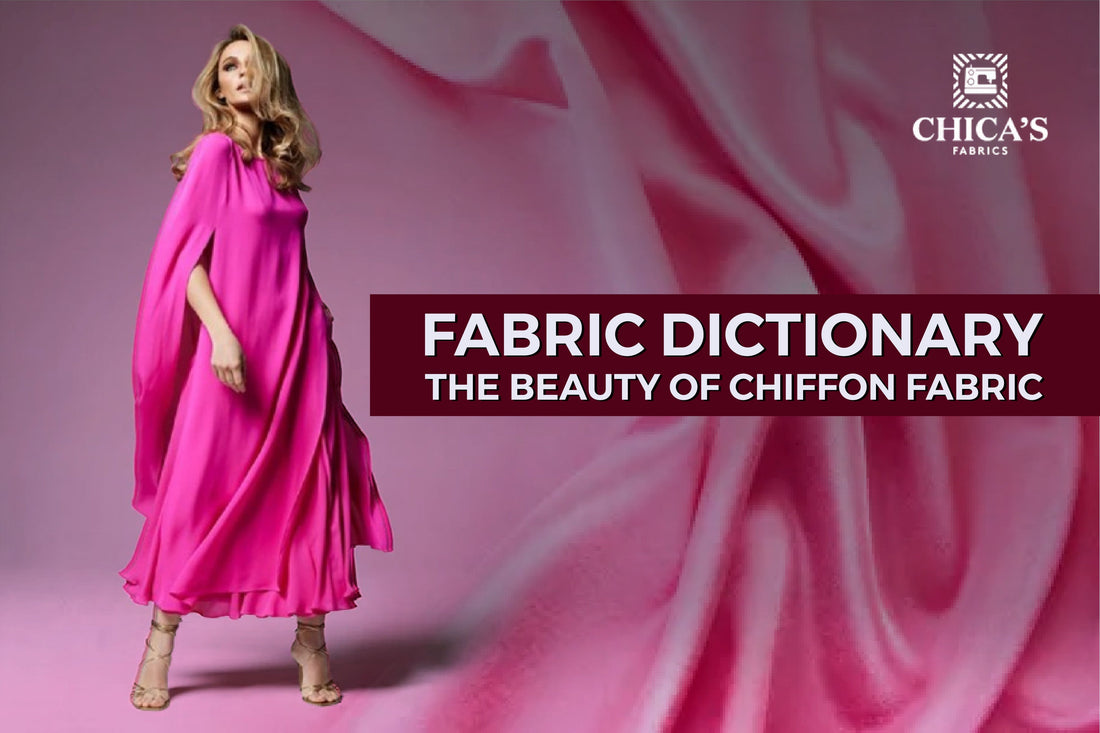
Fabric Dictionary: The Beauty of Chiffon Fabric
Chiffon fabric is the very name that evokes images of elegance and grace. It's a fabric that flows like water, drapes like a dream, and whispers of sophistication. Whether you're a seasoned fashion designer or a curious DIY enthusiast, understanding the unique qualities of chiffon can unlock a world of creative possibilities. This guide will dive into the attractive world of chiffon, exploring its various types, characteristics, and applications. We'll also provide valuable tips on how to style and care for this delicate yet stunning fabric. So, get ready to be surprised by the beauty of chiffon.
What are the Different Types of Chiffon Fabric?
Chiffon comes in a variety of forms, each with its unique characteristics and drape. Understanding the different types of chiffon will help you choose the perfect fabric for your project.
Types of Chiffon:
· Silk Chiffon: Known for its luxurious feel and subtle sheen, silk chiffon is the most delicate and expensive type. It drapes beautifully and is often used in high-end fashion.
· Polyester Chiffon: A more affordable and durable option, polyester chiffon offers a similar look to silk chiffon but is less prone to wrinkles. It's a popular choice for everyday wear and casual garments.
· Rayon Chiffon: Made from regenerated cellulose, rayon chiffon is known for its soft, flowing drape and vibrant colors. It's often used in scarves, blouses, and flowing dresses.
· Nylon Chiffon: A lightweight and resilient fabric, nylon chiffon is often blended with other fibers to enhance its durability and drape. It's a versatile option for various applications, from evening wear to casual tops.
Key Characteristics of Chiffon Fabric
Chiffon possesses several unique characteristics that make it a beloved fabric among designers and DIY enthusiasts alike. Let's get through what makes chiffon so special.
· Sheer and Lightweight: Chiffon is renowned for its sheer and lightweight nature. This quality allows it to drape effortlessly and creates a sense of airy movement.
· Flowing and Drapey: The delicate weave of chiffon contributes to its exceptional drape. It flows gracefully and moves beautifully with the body, making it ideal for creating flowing gowns, skirts, and tops.
· Soft and Delicate: Chiffon feels incredibly soft against the skin, offering a luxurious and comfortable wearing experience.
· Versatile Applications: Due to its versatility, chiffon can be used in a wide range of fashion and home decor applications.
· Potential Drawbacks: While beautiful, chiffon does have some potential drawbacks. It can be prone to fraying, and its sheerness may require careful consideration when choosing undergarments.
What are the Common Uses of Chiffon Fabric?
Chiffon's versatility shines through in its wide range of applications. From elegant evening wear to delicate home decor, chiffon finds its place in numerous creative endeavors.
Common Uses:
· Evening Wear: Chiffon is a perennial favorite in the world of evening wear. Its flowing drape and luxurious feel make it ideal for creating stunning gowns, dresses, and skirts.
· Bridal Attire: Chiffon often graces bridal attire, adding a touch of ethereal beauty to wedding dresses, veils, and overlays.
· Blouses and Tops: Chiffon's lightweight and airy nature makes it perfect for creating breezy blouses, tops, and tunics.
· Scarves and Shawls: Chiffon scarves and shawls offer a touch of elegance and sophistication, while their sheerness provides a hint of coverage.
· Home Decor: Chiffon can also be used in home decor applications, such as curtains, tablecloths, and bed linens, adding a touch of softness and elegance to any space.
How Can I Style Chiffon Fabric?
With its flowing drape and delicate texture, chiffon offers endless possibilities for creative expression. Here are some styling techniques to elevate your designs:
· Draping: Chiffon's lightweight nature makes it an ideal canvas for dramatic drapes and gathers. Experiment with different draping techniques to create flowing gowns, elegant tops, and sculptural silhouettes.
· Pleating: Incorporate pleating techniques like knife pleats, box pleats, and accordion pleats to add texture and dimension to your chiffon creations.
· Layering: Layer chiffon with other fabrics like lace, silk, or tulle to create depth and visual interest. The sheerness of chiffon allows for beautiful layering effects.
· Embellishment: Enhance the elegance of chiffon with delicate embellishments such as beading, embroidery, or sequins. These details can add a touch of sparkle and sophistication.
How to Care for Chiffon Fabric?
Proper care is essential to maintain the beauty and longevity of your chiffon garments. Here are some tips:
· Hand Washing or Dry Cleaning: Chiffon is generally delicate and may not withstand the rigors of machine washing. Hand washing in cold water with a mild detergent is recommended. Alternatively, dry cleaning is a safe option for most chiffon fabrics.
· Ironing and Steaming: To remove wrinkles, use a low heat setting on your iron or use a steamer. Avoid direct contact between the iron and the fabric, as it can cause damage.
· Storage: Store your chiffon garments properly to prevent wrinkles and damage. Hang them on wide hangers to avoid stretching, or fold them carefully and store them in a breathable garment bag.
Conclusion
Chiffon fabric, with its timeless elegance and enduring appeal, continues to captivate designers and fashion enthusiasts alike. Its versatility, from flowing evening gowns to delicate home decor, ensures its place in the world of textiles for years to come. As fashion trends evolve, we can expect to see innovative and exciting new ways to incorporate chiffon into our wardrobes and homes. Embrace the beauty of chiffon, experiment with its endless possibilities, and discover the magic that this exquisite fabric can bring to your creations.
